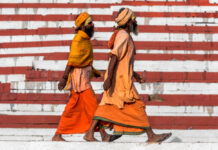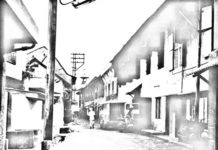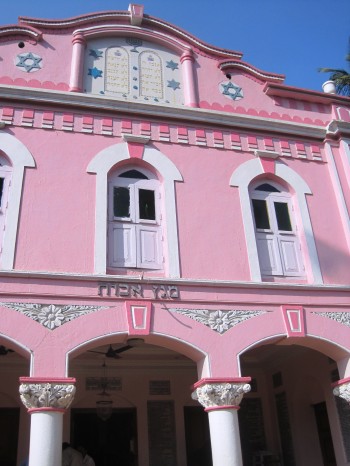Kochi (formerly Cochin) is a city on the South Indian coast, in the State of Kerala boarding the Arabian Sea. There in fact two Kochis, the fabled spice city of the Malabar Coast on Fort Cochin Island, and a newer modern city across the channel. These two cities lie at the mouth of a natural harbor formed where the Vembanad River meet the sea.
The region is beautiful. It is warm, fragrant and tropical. Inland waterways form intricate canals through dense tropical forest punctuated by fields of rice. Small boats ply the inland waterways, elegant houseboats cruise the lakes and back waters.
The geography is relatively new. The port was created by a cataclysmic river flood in 1341 that carved new channels to the sea. In the process it destroyed the ancient city of Cranganore, twenty miles north of the city. The port may have been originally built by Chinese maritime traders not long after the great flood. There is a record of Chinese in the area as early as 1343. The design of the fishing nets along the channel is Chinese and dates from this time (see photos).
The great Portuguese navigator Vasco da Gama first came here in 1498. He returned in 1502. He died here, possibly of malaria in 1524. He was originally buried here in what now in St. Francis Church. His remains were later returned to Portugal. The Old Portuguese city was begun by Pedro Alvares Cabral. The Dutch took over the city in the 1663 followed by the British in 1795. The city remained under British rule until independence.
The Malabar Coast has long been the source of spices for the ancient and medieval world. Arab and Romans traded here primarily for pepper, sometimes called “black gold”. Dried ginger, nutmeg, coriander, cardamom, turmeric and other spices were traded here as well. Whereas the Silk Route emanating from China for the early days of the Roman Empire is now well know, the Spice Route, both by sea to Arabia and by land (up the coast Malabar coast where it joined the silk route west from Afghanistan to Europe and East to China) was also a very important trade route. In fact, much of the early Portuguese and later Dutch exploration of the Orient was in search of spices. Kochi has been central to both ancient and modern spice trades. In addition to spices the area is famous for fish and rice. The food is fragrant, fresh and delicious.
The modern City of Kochi has a different economic base from the old. It is rapidly becoming a major port of entry for Southern India. Dubai is building a major container port. It is already the site of petroleum refineries. New Kochi has become a thriving information technology outsourcing hub as well. Literacy in Kerala is nearly universal. Kerala provides most of the nurses for India and from India much of the world. The government changes from election to election from Communist (with hammer and sickle) to Congress Party regularly.
The world’s major religions have long and deep roots here. The Malabar Coast has a rich tradition of Hindu scholarship and learning dating back more than 2,000 years. Christianity came early with the arrival of Saint Thomas in 62 AD. He established a church which still flourishes here and in Goa, the Syrian Christians. St. Thomas is buried in India, in Chennai (formerly Madras). These Christians date to well before the establishment of what is now the Orthodox Church by Constantine in the Emperor in 330AD. Only the Egyptians Coptic Church that was founded by St. Mark is as old. Catholicism arrived with the Portuguese. Francis Xavier was here and his body is now in the former Portuguese Colony of Goa, just to the north. The Dutch and the British both brought Protestantism here in several forms. The first mosque was built here in wile Mohammed was still alive.
The Jews have a rich history here as well. There was brisk trade with the Levant dating back to before King Solomon’s time, 992-952. People (that now we would call Arabs) and Jews reached the Malabar coast about 3,000 years ago. The Biblical name for India is Odhu. The trade was in teak wood, ivory, spices, sandalwood and rare animals including as peacocks.
With the destruction of the second temple by the Romans in 70 AD, Jews began the Diaspora. It is said a community dating from that time was established in Cranganore to the north of Kochi. This may be apocryphal. What is established is that Joseph Rabban received a treaty from Maharajah Cherramperumal in 379 AD granting the Jewish community rights to live in the Cranganore region. Facsimile copies of the copper plates are available.
A second exodus took place from Cranganore. The reasons are said to be various-the great flood, fighting within the community, pressure from Moslems and the Portuguese. In any event Joseph Aznar and his wife sought and received protection from the maharajah of Cochin in 1524. The construction of the last remaining functioning synagogue on the grounds f the maharajah’s palace began in 1568.
There are a total of six synagogues in and near Kochi. The one called the Pardesi Synagogue stands today and is still in use by the very few Jews remaining here. Pardesi is generally a derogatory word meaning foreigner. It may be that this synagogue was so named as it is a Sephardic Jewish synagogue meaning that the founders were part of the great Spanish exodus begun in 1492. The other synagogue I visited here, now in ruins, is called “The Black Jewish Church” by the locals. It may be the name (Black Jews) that the newcomers gave to the established Jewish community. The other four local synagogues are in similar ruin or are repurposed as residence or commercial buildings. The last maharajah of Cochin gave a farewell address to his Jewish subjects in1949.
The old town of Cochin is charming. It is filled with colonial buildings dating back more than 500 years. The murals in the Maharajah’s palace are amongst the best in India. The food is delicious, the climate excellent even now in the monsoon, and hotels elegant and graceful. The music and dance is exceptional. Kochi is a wonderful place to be.
To see the original source and author of this please go to this URL:
http://www.theatlantic.com/personal/archive/2010/08/a-day-in-kochi/61713/




